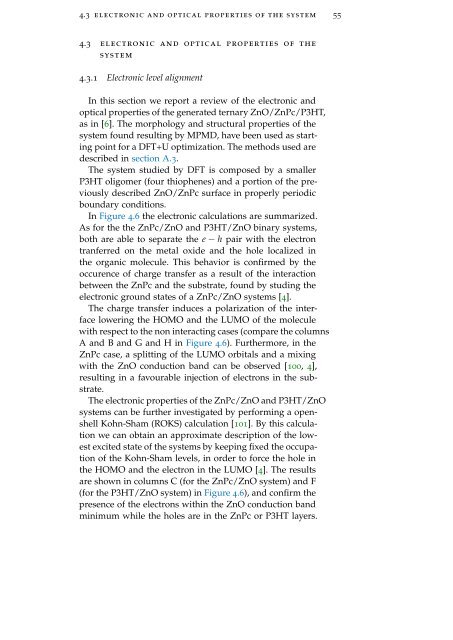Documento PDF - UniCA Eprints - Università degli studi di Cagliari.
Documento PDF - UniCA Eprints - Università degli studi di Cagliari.
Documento PDF - UniCA Eprints - Università degli studi di Cagliari.
You also want an ePaper? Increase the reach of your titles
YUMPU automatically turns print PDFs into web optimized ePapers that Google loves.
4.3 electronic and optical properties of the system 554.3 electronic and optical properties of thesystem4.3.1 Electronic level alignmentIn this section we report a review of the electronic andoptical properties of the generated ternary ZnO/ZnPc/P3HT,as in [6]. The morphology and structural properties of thesystem found resulting by MPMD, have been used as startingpoint for a DFT+U optimization. The methods used aredescribed in section A.3.The system <strong>stu<strong>di</strong></strong>ed by DFT is composed by a smallerP3HT oligomer (four thiophenes) and a portion of the previouslydescribed ZnO/ZnPc surface in properly perio<strong>di</strong>cboundary con<strong>di</strong>tions.In Figure 4.6 the electronic calculations are summarized.As for the the ZnPc/ZnO and P3HT/ZnO binary systems,both are able to separate the e − h pair with the electrontranferred on the metal oxide and the hole localized inthe organic molecule. This behavior is confirmed by theoccurence of charge transfer as a result of the interactionbetween the ZnPc and the substrate, found by <strong>stu<strong>di</strong></strong>ng theelectronic ground states of a ZnPc/ZnO systems [4].The charge transfer induces a polarization of the interfacelowering the HOMO and the LUMO of the moleculewith respect to the non interacting cases (compare the columnsA and B and G and H in Figure 4.6). Furthermore, in theZnPc case, a splitting of the LUMO orbitals and a mixingwith the ZnO conduction band can be observed [100, 4],resulting in a favourable injection of electrons in the substrate.The electronic properties of the ZnPc/ZnO and P3HT/ZnOsystems can be further investigated by performing a openshellKohn-Sham (ROKS) calculation [101]. By this calculationwe can obtain an approximate description of the lowestexcited state of the systems by keeping fixed the occupationof the Kohn-Sham levels, in order to force the hole inthe HOMO and the electron in the LUMO [4]. The resultsare shown in columns C (for the ZnPc/ZnO system) and F(for the P3HT/ZnO system) in Figure 4.6), and confirm thepresence of the electrons within the ZnO conduction bandminimum while the holes are in the ZnPc or P3HT layers.
















